
Emily FitzGerald, Duchess of Leinster, known before 1747 as Lady Emily Lennox, from 1747 to 1761 as The Countess of Kildare and from 1761 to 1766 as The Marchioness of Kildare, was the second of the famous Lennox sisters, daughters of Charles Lennox, 2nd Duke of Richmond.
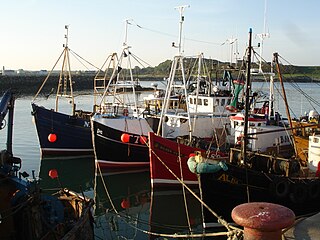
Ardglass is a coastal fishing village, townland and civil parish in County Down, Northern Ireland, in the historic barony of Lecale Lower. It is still a relatively important fishing harbour. It is situated on the B1 Ardglass to Downpatrick road, about 6 miles to the south east of Downpatrick, in the Lecale peninsula on the Irish Sea. It had a population of 1,668 in the 2001 Census, and is located within the Newry, Mourne and Down area.
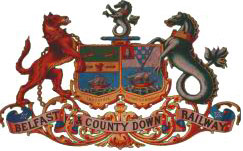
The Belfast and County Down Railway (BCDR) was an Irish gauge railway in Ireland linking Belfast with County Down. It was built in the 19th century and absorbed into the Ulster Transport Authority in 1948. All but the line between Belfast and Bangor was closed in the 1950s, although some of it has been restored near Downpatrick by a heritage line, the Downpatrick and County Down Railway.

Ardtole Church is a 15th-century ruined church standing on a hilltop overlooking the Irish Sea and the Isle of Man, 0.75 miles (1.2 km) north-east of the town of Ardglass in County Down, Northern Ireland, at grid ref: J564382. It has been in ruins since at least 1657 when it was described as "only old walls".
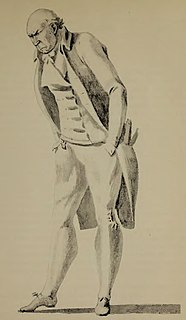
William Ogilvie (1740–1832) was a Scottish-born scholar and tutor.

Bangor Castle is a country house situated in Castle Park in Bangor, County Down, Northern Ireland. The building, which is also referred to as Bangor Town Hall and is now used as the offices of Ards and North Down Borough Council, is a Grade A listed building.

Kilclief Castle is a tower-house castle beside Strangford Lough and 2.5 miles (4 km) south of the village of Strangford, County Down, Northern Ireland. Kilclief is a hamlet of historical value on the Strangford to Ardglass road.

Audley's Castle is a 15th-century castle located 1 mile (1.6 km) north-east of Strangford, County Down, Northern Ireland, on a rocky height overlooking Strangford Lough. It is a three-storey Tower house named after its 16th century owner, John Audley. Audley's Castle tower house and bawn is a State Care Historic Monument in the townland of Castleward, in Down District Council area, at grid ref: J5781 5058.
Vice-Admiral Charles James FitzGerald, 1st Baron Lecale PC (Ire), styled Lord Charles FitzGerald between 1761 and 1800, was an Irish naval commander and politician.

Gosford Castle is a 19th-century country house situated in Gosford, a townland of Markethill, County Armagh, Northern Ireland. It was built for The 2nd Earl of Gosford, and designed in the Norman revival style by London architect Thomas Hopper. It is a Grade A listed building, and is said to be Ulster's largest. The Earls of Gosford occupied the castle until 1921, and the estate was later purchased by the Ministry of Agriculture to form Gosford Forest Park. The building subsequently deteriorated and in 2006 was sold to a development company who converted the castle into private dwellings.
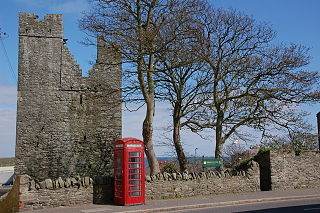
Jordan's Castle is a castle situated in Ardglass, County Down, Northern Ireland. The tower house known as Jordan's Castle is a State Care Historic Monument sited in the townland of Ardglass, in the Newry, Mourne and Down District Council area, at grid ref: J5601 3713. It stands close to the junction of Kildare and Quay Streets in Ardglass and commands the harbour.
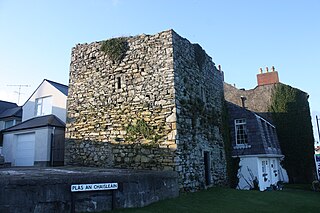
Margaret's Castle is a castle in Ardglass, County Down, Northern Ireland. It is a small Tower house probably built in the 15th century. Only two storeys still exist but there is evidence that it was at least three storeys high. It is vaulted above the ground floor with a rectangular tower with projecting turrets in the north west wall. The doorway between the turrets was protected by a murder-hole. A spiral stairway rises within the west turret.
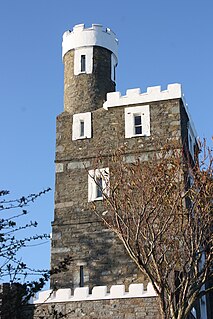
King's Castle is a castle in Ardglass, County Down, Northern Ireland. It was originally built in the 12th century and additions were made at various times over the centuries. It was rebuilt in the 19th century to the original specifications after parts of it collapsed in 1830 during repairs to the castle's foundation: restoration finished in 1988 and the castle opened as a nursing home and remains one today.
Mjr.Aubrey William de Vere Beauclerk was a Radical British Member of Parliament (MP), who was elected to serve the dual-member East Surrey, making contributions in the Commons between 1833 and 1837, when he did not stand for re-election. One of his great-grandfathers was a younger son of the 1st Duke of St Albans (paternal-line-only), two of the others were the 3rd Duke of Marlborough and 2nd Duke of Richmond.

Dunlough Castle, standing atop the cliffs at the northern tip of the Mizen Peninsula, looks at the Atlantic Ocean from the extreme southwest point of Ireland. Founded in 1207 by Donagh O’Mahony, Dunlough is one of the oldest castles in southern Ireland and an example of Norman architecture and dry stone masonry.

Castle Donovan or Castledonovan or O'Donovan's Castle refer to the remains of an Irish tower house or túrtheach, in a valley near Drimoleague, of medium size which was the so-called "seat" of the Clann Cathail sept of the O'Donovans for a period during the 16th century. The original name of the castle, and when the O'Donovans were actually living in it, was Sowagh before the 17th century. The name of Castle Donovan, after the Manor of the Castle of O'Donovan, is associated with a regrant from James II of England in 1615. Approximately 60 feet in height, it sits on a large rock or outcropping, which forms the ground floor, close to the bank of the River Ilen. It is commonly believed to have been built, or at the very least augmented, by Donal of the Hides, Lord of Clancahill from about 1560 to his death 1584. His son Donal II O'Donovan then repaired or further altered the structure some decades later, but was not living in it by then. It is believed that his father had already relocated the family in the first decade of that century to the more profitable Rahine Manor on the seacoast to protect their maritime interests.

Lecale is a peninsula in the east of County Down, Northern Ireland. It lies between Strangford Lough and Dundrum Bay. In the Middle Ages it was a district or túath in the Gaelic Irish kingdom of Ulaid, then became a county in the Anglo-Norman Earldom of Ulster. Later it became a barony, which was split into Lecale Lower and Lecale Upper by 1851. Its largest settlement is the town of Downpatrick. Other settlements include Ardglass, Killough and Strangford. The peninsula has a high concentration of tower houses. Much of it is part of the 'Strangford and Lecale' Area of Outstanding Natural Beauty.
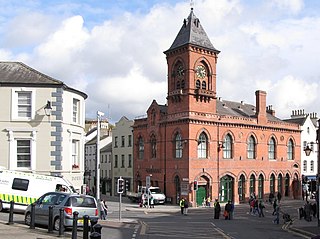
The Down Arts Centre, formerly Downpatrick Town Hall and also Downpatrick Assembly Rooms, is a municipal structure in Irish Street in Downpatrick, County Down, Northern Ireland. The structure, which was the meeting place of Down Urban District Council, is a Grade B1 listed building.

Ballyclare Town Hall is a municipal structure in The Square, Ballyclare, County Antrim, Northern Ireland. The structure, which is primarily used as an events venue, is a Grade B2 listed building.


















